The Macon Levee
Friends of Ocmulgee Old Fields
The Macon Levee in 2009
Macon's
levee
inspection
|
||
| |
Thursday, Jun. 18, 2009 Macon levee
inspection nearly finished
By Phillip Ramati - pramati@macon.com http://www.macon.com/198/story/751799.html (some photos are online) Macon Mayor Robert Reichert hadn’t settled in on his first day in office in 2007 when the U.S. Army Corps of Engineers paid him a visit. 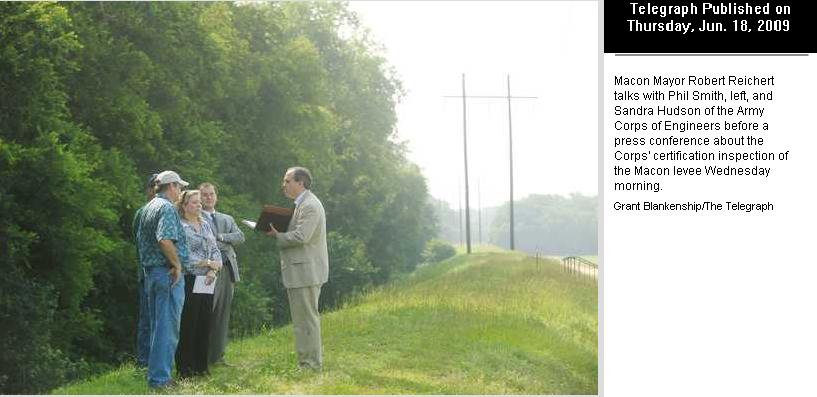 The agency’s representatives told him that Macon’s levee could lose its certification and possibly federal funding unless certain requirements were met, including cutting down mature trees on the earthen embankment. Members of the corps began evaluating the city’s levee Wednesday morning. The agency is scheduled to finish its survey today, but its formal report won’t be presented to the city for several weeks. Informal checks this year indicated that the city has made the improvements necessary to maintain federal flood protection. Reichert said Wednesday that the city had worked closely with the Macon Water Authority to make certain that all of the corps’ requirements have been met. “We evaluated the situation and determined what we needed to do,” Reichert said. “We partnered with the Macon Water Authority, and they took the lead role to keep the levee from being decertified.” Loss of certification meant the city would become ineligible for federal funds should there be a flood and the levee had failed. The root of the problem? The roots and large trees along the levee. Phil Smith, a safety engineer with the corps’ Savannah District Levee Program, said vegetation issues are common for most levees. Though his inspection won’t conclude until today, Smith said photos he has seen of the levee showed that the city has had the trees removed. Trees can undermine the integrity of the embankment, because if a tree is knocked over by heavy winds or flooding, the roots can pull out large chunks of the levee. “We’ve seen that Macon has been doing work on its levee,” Smith said. “Vegetation is the big issue with most levees, and it always will be.” For many years, Reichert said, the corps hadn’t been strict in enforcing the rules for levees. But after the Flood of 1994 in Macon, combined with the national attention that levees received when they collapsed in New Orleans during Hurricane Katrina in 2005, the corps has been much more strict in making sure that all levees meet all qualifications for certification. “What was acceptable before was not acceptable now,” the mayor said. Over the years, the city had contended that the levee’s problems were a design issue, Reichert said, but the corps has countered that they were a maintenance issue. Now, Reichert said, “We’re on the same page as the Corps of Engineers.” Bill Causey, head of the city’s engineering department, said it cost about $350,000 to remove the trees and their roots, then rebuild those sections of the levee. The city also has been doing work repairing a sinkhole that formed near the levee in April. That repair work is costing about $86,000, according to reports. Information from The Telegraph’s archives was used in this report. To contact writer Phillip Ramati, call 744-4334 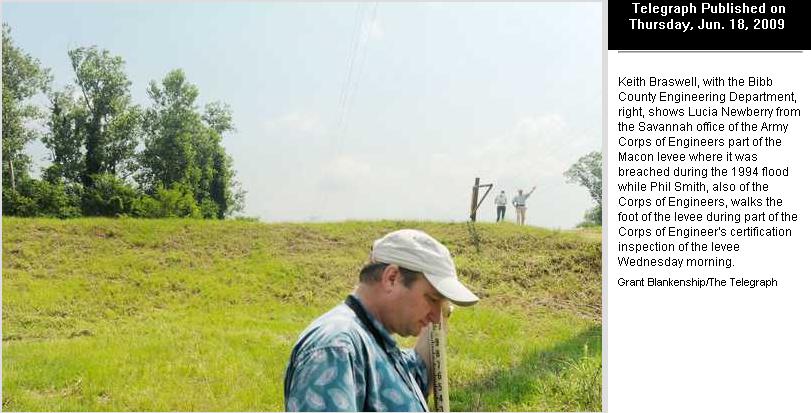 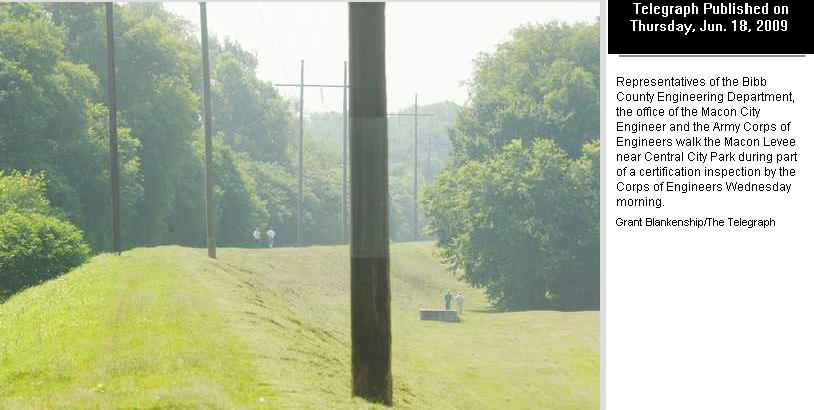 |
|
|
|
||
| Thursday, Jun. 11, 2009 http://www.macon.com/198/story/744412.html Macon sinkhole mystery solved By S. Heather Duncan - hduncan@macon.com After two months, the Macon Water Authority has determined the cause of a sinkhole that opened in Central City Park near Macon’s levee and hired a contractor to fix the problem. 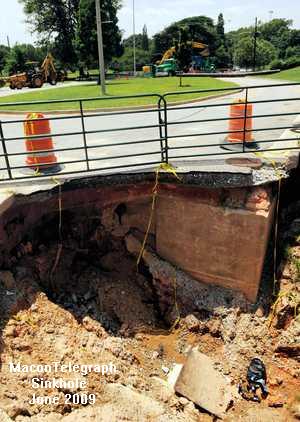 When the collapsed area was cleared out with an excavator, employees found a hole about 6 feet long and 18 inches wide in the top of a large sewer pipe, Assistant Executive Director Ray Shell said. Heavy rains evidently caused a large volume of dirt to wash into the pipe, causing the sinkhole, Shell said. Originally, authority officials had believed the hole was probably related to water undermining the Macon levee, because at first water levels in the hole correlated with the height of the Ocmulgee River. The U.S. Army Corps of Engineers is responsible for certifying the safety of the Macon levee. Bill Causey, director of the Macon Engineering Department, said corps officials meeting with local representatives about the sinkhole expressed skepticism that it was related to the levee. “So (the authority) dug deep enough and sure enough, they found the hole,” Causey said. “This is definitely our problem,” Shell said. “When we saw the hole in the pipe, we knew we had to replace it.” He said the authority also will replace the sidewalk at the foot of the river trail under the direction of the city. Corps officials plan to inspect the levee starting Tuesday, said Sandra Hudson, spokeswoman for the corps’ Savannah district. The inspection will determine whether the levee maintains its certification, which offers flood protection to homes and businesses behind it. Last year, the authority removed hundreds of trees from a southern portion of the levee to bring it into compliance, and it has not yet been reinspected. Since Hurricane Katrina, the corps has required the removal of trees from levees nationwide, saying that their roots undermine levee stability. Causey said he doesn’t expect the sinkhole to be a factor in the inspection. Shell said the hole has not refilled with water since it first fell in, and sewage has not been escaping from the pipe. The authority has hired Pyles Construction of Macon to replace part of the pipe and install an epoxy lining to prevent corrosion, at a cost of about $86,000, Shell said. At the same time, the authority will check several hundred more feet of the large sewer line that runs through Central City Park to make sure it is not in danger of failure. Earth moving equipment was at work in the park Wednesday, with large pipes snaking toward the playground. The pipe could be replaced Monday, with the rest of the repairs around the sinkhole continuing into the next week, Shell said. Macon and authority officials had speculated that the sinkhole might have been caused by an abandoned sewer line that runs through the park, which could channel water under the levee if not properly closed off. Causey has said this line was a problem in the place where the Ocmulgee breached its levee during 1994’s Tropical Storm Alberto. Causey said he understands that the authority intends to check the old line. But because the sinkhole seems to have had another cause, the authority doesn’t plan to further investigate the abandoned line at this time, Shell said. If the line was involved in the breaching of the levee 15 years ago, Shell said he was unaware of it. To contact writer S. Heather Duncan, call 744-4225 Yankee1967 wrote on 06/11/2009 08:17:34 PM: Golly - Shazam! Only 2 months to find the hole in the pipe. What if there had been a real emergency, like a flood threat from the river? Swim Forrest Swim. greenconner wrote on 06/11/2009 12:46:33 PM: They say, "sinkhole." I say "Macon municipal swimming pool" graycitizen wrote on 06/11/2009 09:41:09 AM: Two months to find out ... otherwiser wrote on 06/11/2009 02:16:26 AM: Maybe Dr Holliday's historic archives on the Levee & Flood will reveal some clues: www.macon-bibb.com/Levee.htm |
||
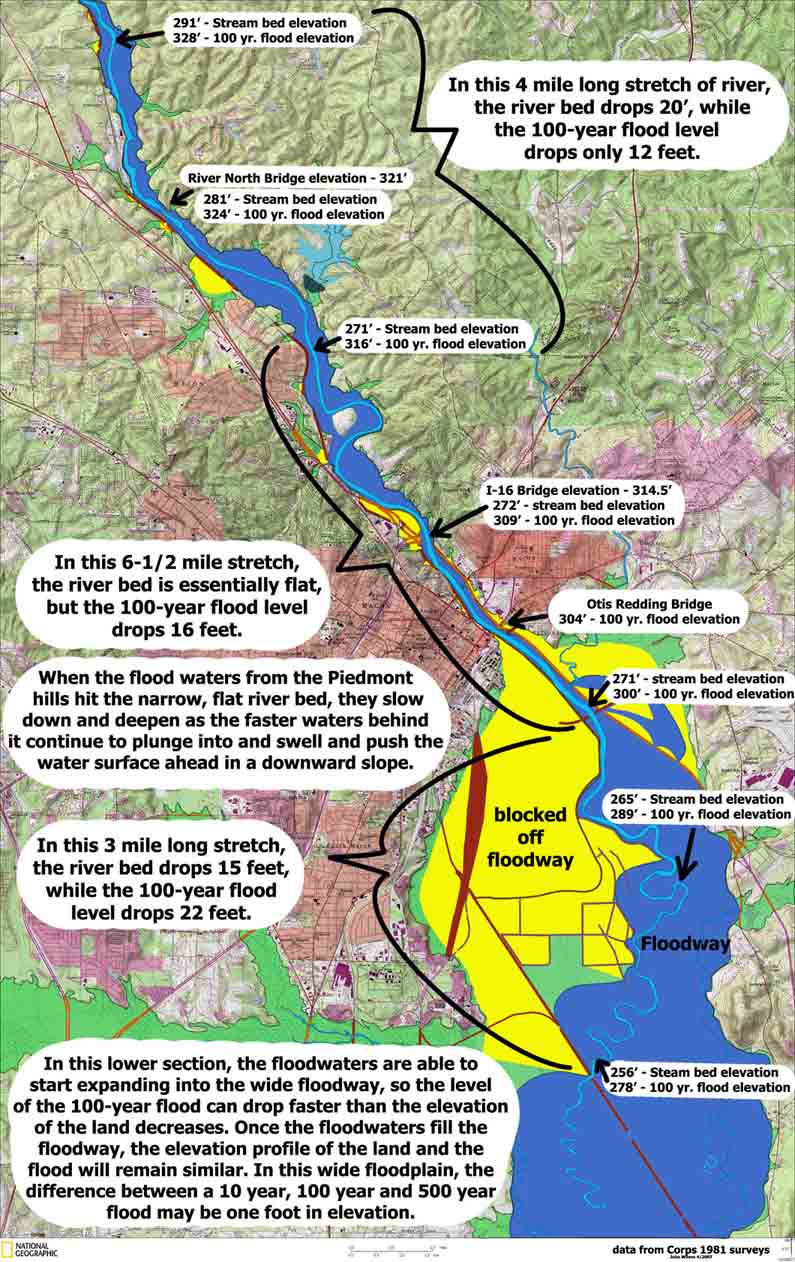 |
||
| Thursday, Dec. 10, 2009
Major sewer line near site of levee sinkhole cleared By S. HEATHER DUNCAN - hduncan@macon.com http://www.macon.com/local/story/947676.html Fifty years of debris was dragged from sewer lines in buckets as the Macon Water Authority repaired sewer pipes that run through Central City Park and underneath the Macon levee. Now the work, which began in September after a pipe crumbled at the foot of the Macon levee, is mostly complete, Macon Water Authority Director Tony Rojas said. The pipe collapse caused a sinkhole which threatened the levee and caused the authority to shut off pumps that moved sewage through the line. As a result, the authority calculates that about 37.5 million gallons of sewage spilled onto the Ocmulgee Heritage Trail and at the Ocmulgee National Monument The authority bored under the levee to install a new pipe, cleaned and lined 700 feet of 52-inch pipe, and fixed two manholes as part of the project, Rojas said. A force main was installed to keep sewage moving in the pipe all the time so gases from decomposition would not cause corrosion as they did in the pipe that failed, Rojas said. The whole project cost $1.4 million, Rojas said. The pipes that run through Central City Park had not been cleaned in half a century, Rojas said. “The bottom of the pipe was two feet of hardened sediment. ... We had to put people in the pipe with hammers and chisels.” He said workers had to use a boom to remove a huge amount of rope-type mop material that had been dumped in the pipe decades ago. Rojas said the authority is now paying a contractor $60,000 to use sonar to check the pipe between the park and Lower Poplar sewage treatment plant for obstructions, and the authority plans to continue that every two years. Rojas said some sidewalk repair and grassing still needs to be completed in the park, but the work is otherwise done. In a related issue, in September the U.S. Army Corps of Engineers asked the water authority to evaluate whether an abandoned sewer line could destabilize the levee. If the old line remains open inside, it could cause soil in the levee to shift. Rojas said the authority plans to investigate that and grout the pipe full if necessary, but not immediately. “We have told the corps we’ll fill in the pipe over time, that we’ll program it into our spending year by year,” Rojas said. “They basically said they could work with that.” |
||